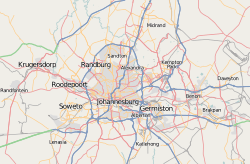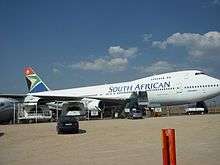Rand Airport
| Rand Airport | |||||||||||||||
|---|---|---|---|---|---|---|---|---|---|---|---|---|---|---|---|
|
Rand Airport Control Tower from landside | |||||||||||||||
| Summary | |||||||||||||||
| Airport type | Public | ||||||||||||||
| Operator | Rand Airport Management Company (Pty) Ltd. | ||||||||||||||
| Location | Germiston, Gauteng | ||||||||||||||
| Elevation AMSL | 1,671 m / 5,482 ft | ||||||||||||||
| Coordinates | 26°14′33″S 028°09′04″E / 26.24250°S 28.15111°ECoordinates: 26°14′33″S 028°09′04″E / 26.24250°S 28.15111°E | ||||||||||||||
| Website | http://www.randairport.co.za | ||||||||||||||
| Map | |||||||||||||||
 QRA Location in the Johannesburg area | |||||||||||||||
| Runways | |||||||||||||||
| |||||||||||||||
Rand Airport (IATA: QRA, ICAO: FAGM) is an airport in Germiston, South Africa. It was constructed in the 1920s as the main airport for Johannesburg, but the city outgrew it and replaced the airport with Palmietfontein Airport in the late 1940s (itself replaced by Jan Smuts International Airport in the 1950s).
History
Pre World War II
In 1917, Major Allister Miller landed on Germiston Golf Course and thought the area close by would be suitable as an airfield due to its location to Johannesburg, the landmark of Victoria Lake and the well drained land.[1]:1034 But it would take until February 1929, for the three interested parties to agree for 400 acres of land to be set aside for what was called the Germiston Public Aerodrome.[1]:1034 The three parties were the Germiston Town Council, Elandsfontein Estate Company and the Rand Refinery.[1]:1034 Later that year, the Germiston Town Council gained full control and further plans were developed for the aerodrome when Imperial Airways was thinking of adding South Africa to their flight schedules.[1]:1035 After the involvement of the South African government, they were able to convince the airline that Johannesburg, with its mining and industry, should be their base rather than Cape Town, with Rand Refinery seeking to export is refined gold by air.[1]:1035
The Imperial Airways would receive a ₤400,000 subsidy from the South African and British Government's over five years.[1]:1036 In November 1929, the Germiston Town Council bought a further 700 acres of land for ₤14,000, after permission was given by the Mining Commissioner, as the land was owned by the Simmer and Jack mine with the understanding that the land could be reacquired as a mining area.[1]:1035 In order to proceed with the development, the Johannesburg and Germiston Town Council's formed a joint committee on 14 November 1930 and ₤85,000 was set aside for infrastructure.[1]:1036 This would consist of a large and small hanger, administrative buildings, workshop, floodlights and cottages.[1]:1036
The airport was officially opened on 21 December 1931[2] by the Governor-General Earl of Clarendon and owned jointly by the Germiston and Johannesburg Town Council.[1]:1036 In 1932, Captain Roy Makepeace became its manager.[1]:1036 It became the headquarters of South African Airways (SAA) when the airline's head office was moved from Durban to Rand Airport on 1 July 1935.[3] By 1938, the development costs had reached ₤200,000 and losses of ₤20,000, a cost the Germiston Town Council could no longer afford and so sold its share to the Johannesburg City Council for ₤106,498, with 207 acres of land not used resold to the former and land provided for a future highway to connect to the Heidelberg road.[1]:1036 The final transfer took place in 1944.[1]:1036
In early 1939, the Union Defence Force took control of Rand Airport and by May 1940, all commercial flights ended.[1]:1037 The training schools based there would train pilots for the war effort and the facilities were extended with fifteen additional hangers built.[1]:1037 By 1944, a limited number of internal commercial flights resumed from the airport.[1]:1037
Post World War II
SAA moved its headquarters to Palmietfontein Airport in 1948 because of runway length constraints. Nevertheless, Rand Airport grew quickly after the World War II because of the pool of ex air-force pilots. In 1975, with 133 135 recorded aircraft movements, Rand Airport was the busiest airport in the southern hemisphere.[4]
The ownership of the airport originally consisted of 23 private shareholders and there has been very little change. Most of the re-sales have been taken up by existing owners under new company names so there has been a small increase to the current 25 owners, plus the Mayondi BEE consortium and Ekurhuleni Town Council.[5]

Rand Airport today
Today, the airport hosts air charter operators, flying schools and a number of aircraft maintenance organisations, as well other aviation-related enterprises.[6] Charter operator Phoebus Apollo Aviation has its headquarters at Rand; the airport is also home to the Flying Lions Aerobatic Team.
South African Airways donated a Boeing 747-200 and a Boeing 747SP to the South African Airways Museum Society which are on display at the airport. The airport also hosts an annual air show.[7]
Airlines and destinations
There are no scheduled operations from the airport.
Hot and high conditions
Rand Airport is notorious for its hot and high conditions and relatively short runways. Situated at an altitude of 1,600 metres (5,200 ft) above sea level, the density altitude is as high as 2,400 metres (7,900 ft) when the outside air temperature (OAT) is 30 °C. Special consideration must be given to flight planning in the summer when the ambient temperature is that high; there have been many accidents at this airfield as a result of reduced aircraft performance under these extreme conditions. A compounding factor is the lack of forced landing fields or areas, as the airport is surrounded by urban sprawl.
Notable accidents and incidents
- On 6 October 1970 at about 7:10 am, Douglas DC-3 registration ZS-DKR en route for Orapa, Botswana crashed as it attempted to return to Rand Airport after the left engine failed just after take-off. There were two crew and ten passengers aboard. The Captain and two passengers subsequently died of injuries. The aircraft was completely burnt-out after impact.[8]
- On 2 August 1995, an Antonov An-2 on a cargo flight from Rand airport to Jamba, Angola, crashed shortly after takeoff killing all three persons on board. The accident was attributed to the cargo which was not properly secured and shifted during the initial climb out, rendering the aircraft uncontrollable.[9]
- On 6 December 1999 a Piper PA-31-350 crashed shortly after takeoff after suffering an engine failure. All ten people on board were killed.
References
- 1 2 3 4 5 6 7 8 9 10 11 12 13 14 15 16 Shorten, John R. (1970). The Johannesburg Saga. Johannesburg: John R. Shorten Pty Ltd. p. 1159.
- ↑ Rand Airport, About Us Archived 6 March 2010 at the Wayback Machine.. Retrieved 20 April 2013
- ↑ "History". South African Airways Museum Society. Retrieved 16 May 2011.
- ↑ http://ujdigispace.uj.ac.za/handle/10210/7106. Retrieved 18 January 2014
- ↑ "Archived copy". Archived from the original on 6 March 2010. Retrieved 25 November 2009.
- ↑ "Archived copy". Archived from the original on 30 November 2009. Retrieved 25 November 2009.
- ↑ "Archived copy". Archived from the original on 6 March 2010. Retrieved 25 November 2009.
- ↑ ‘The Star’ Johannesburg, 6 October 1970 p1, 11 January 1971, p 1 and 30 March 1971, p 5. Rand Daily Mail 7 October 1970 p1
- ↑ "ASN Aircraft accident Antonov 2R RA-05708 Johannesburg-Randgermiston Airport (QRA)". aviation-safety.net.
External links
| Wikimedia Commons has media related to Rand Airport. |
- Official site
- South African Airways Museum Society
- Airport information for FAGM at World Aero Data. Data current as of October 2006.
- Webcam looking to the west on the airport
- Webcam looking to the east on the airport